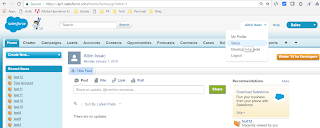How to upload and install the packages through Java API - Adobe Experience Manager(AEM)
This post will explain the approach to upload and install the packages through JAVA.
Refer the post for details on creating the package through Java - https://www.albinsblog.com/2018/01/sling-scheduler-to-auto-create-packages-JcrPackageManager-api-aem.html
Sample Servlet to upload and install the package - Convert the servlet to scheduler and import/replicate the package based on the scheduled time
import java.io.File;
import java.io.IOException;
import java.util.HashMap;
import java.util.Map;
import java.util.Set;
import javax.jcr.Session;
import javax.servlet.ServletException;
import org.apache.felix.scr.annotations.Reference;
import org.apache.felix.scr.annotations.sling.SlingServlet;
import org.apache.jackrabbit.vault.fs.io.ImportOptions;
import org.apache.jackrabbit.vault.packaging.JcrPackage;
import org.apache.jackrabbit.vault.packaging.JcrPackageManager;
import org.apache.jackrabbit.vault.packaging.Packaging;
import org.apache.sling.api.SlingHttpServletRequest;
import org.apache.sling.api.SlingHttpServletResponse;
import org.apache.sling.api.resource.ResourceResolver;
import org.apache.sling.api.resource.ResourceResolverFactory;
import org.apache.sling.api.servlets.SlingAllMethodsServlet;
import org.apache.sling.api.servlets.SlingSafeMethodsServlet;
import org.apache.sling.jcr.api.SlingRepository;
import org.apache.sling.settings.SlingSettingsService;
import com.day.cq.replication.ReplicationActionType;
import com.day.cq.replication.Replicator;
/**
* Servlet that writes some sample content into the response. It is mounted for
* all resources of a specific Sling resource type. The
* {@link SlingSafeMethodsServlet} shall be used for HTTP methods that are
* idempotent. For write operations use the {@link SlingAllMethodsServlet}.
*/
@SuppressWarnings("serial")
@SlingServlet(paths= "/services/packageupload")
public class PackageUploadServlet extends SlingSafeMethodsServlet {
@Reference
private Packaging packaging;
@Reference
private SlingRepository repository;
@Reference
private ResourceResolverFactory resolverFactory;
@Reference
private SlingSettingsService settingsService;
@Reference
Replicator replicator;
@Override
protected void doGet(final SlingHttpServletRequest req, final SlingHttpServletResponse resp)
throws ServletException, IOException {
Session session = null;
if (isRunMode("author") && isMasterRepository()) {//Only run in author - change the servlet to scheduler and import/replicate the package based on the scheduled time
try {
String packagePath = "C:\\Albin\\test12018-01-14-15-00-00-023-1.0.zip";
Map<String, Object> param = new HashMap<String, Object>();
param.put(ResourceResolverFactory.SUBSERVICE, "packageService");
ResourceResolver resolver;
resolver = resolverFactory.getServiceResourceResolver(param);
session = resolver.adaptTo(Session.class);
JcrPackageManager jcrPackageManager = packaging.getPackageManager(session);
JcrPackage inputPackage=jcrPackageManager.upload(new File(packagePath), false, true, "test12018-01-14-15-00-00-023-1.0");
ImportOptions importOption=new ImportOptions();//Specify the import configurations
inputPackage.install(importOption);
//Replicate the package to publishers
replicator.replicate(session, ReplicationActionType.ACTIVATE, inputPackage.getDefinition().getNode().getPath().split("/jcr:content")[0]);
resp.getOutputStream().println("This package successfully uploaded and installed to the server....");
} catch (Exception e) {
// TODO Auto-generated catch block
resp.getOutputStream().println("Excpetion while uploading/installing the package...."+e.getMessage());
e.printStackTrace();
}finally {
if(session!=null)
{
session.logout();
}
}
}
}
private Boolean isRunMode(String mode) {
Set<String> runModes = settingsService.getRunModes();
for (String runMode : runModes) {
if (runMode.equalsIgnoreCase(mode)) {
return true;
}
}
return false;
}
public boolean isMasterRepository() {
final String isMaster = repository.getDescriptor("crx.cluster.master");
return isMaster != null && !isMaster.equals("") && Boolean.parseBoolean(isMaster);
}
}








